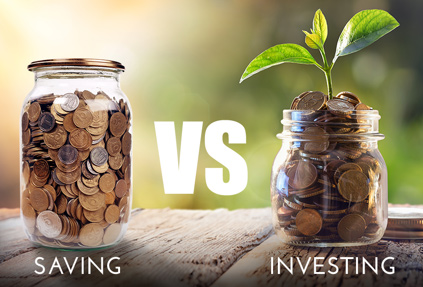Savings VS Investing
When comparing “savings vs. investing,” it is essential to understand the different functions and advantages that each plays in financial planning. Savings are mainly used for immediate necessities and as a safety net; they are frequently kept in easily accessible, low-risk accounts. Savings offer security and liquidity despite low returns, making them appropriate for unexpected costs or emergencies. Nevertheless, investing aims to build money over the long run and experience growth. Due to market volatility, it has a higher level of risk but has the potential to yield superior returns over an extended time. A well-rounded financial plan must strike a balance between the two, adjusting the course of action according to time horizons, risk tolerance, and personal goals.
Starting a frugal lifestyle raises the question: Will frugal living make me rich? Despite dispelling the myth that = “you can’t save enough to be rich,” = living frugally is a highly effective way to accumulate the capital to invest. Living within your means is a discipline that promotes regular savings and builds up a reserve of money that may be wisely invested. Financial prosperity is not only achieved through saving money; the combination of frugality, saving, and wise investments facilitate it. One can create a sustainable path toward potential wealth by prioritizing prudent expenditure, accumulating cash through frugal behaviors, and allocating those resources to wise investments.
Saving vs Investing
Investing and saving play different roles but are essential to sound financial planning. Long-term wealth growth is fueled by investing, while savings act as a safety net, offering stability and liquidity for immediate needs. Together, these two techniques provide a balanced and customized approach to finance that can meet short-term and long-term financial goals by fusing the growth potential of strategic investments with the security of savings.
The security and liquidity of savings accounts ensure that your money is always available when needed. They are, therefore, ideal for short-term objectives like emergency fund building or vacation savings. However, Savings account interest rates are usually lower than riskier investment options. The lower returns explain the low risk associated with banks’ efforts to give depositors a stable and secure environment. Even though savings accounts might not provide much growth, they are essential to a well-balanced financial strategy because of their dependability and accessibility, particularly for unforeseen events and short-term needs.
Investing is a financial strategy that distributes money among different assets, including stocks, bonds, and real estate. Achieving long-term growth and larger returns is the main objective. Stocks are a kind of ownership in firms that have the potential to appreciate over time and provide dividend payouts. However, bonds are debt instruments that guarantee principal repayment and interest payments upon maturity. Rental proceeds or property value growth are two ways that real estate investments can pay off. Understanding one’s risk tolerance is essential for risk management, as is diversification, which involves distributing investments among various assets. Keeping a long-term outlook is crucial, acknowledging that markets may experience short-term volatility but have traditionally shown overall growth. Consulting with financial experts can yield recommendations tailored to individual financial goals and circumstances.
Savings
Safety and Accessibility
Saving money in bank accounts offers accessibility and security. Bank accounts are seen as secure and provide financial protection. They also offer simple access, which is helpful for short-term financial objectives or situations of emergency. They are, therefore, the perfect option for people who want to protect their investments while still having easy access to their money.
Lower Risk
Savings accounts are a good option for conservative financial strategies because they carry less risk. These accounts are a safe option for people who value consistency in their financial strategy because they offer lower risk than more volatile investing possibilities. Savings account returns may be low, but they are generally less risky, which fits nicely with a conservative investing mindset.
After all, savings accounts usually have lower interest rates, which translates into limited but steady profits. Compared to riskier assets, they provide a safer alternative, but the trade-off has a lower potential for growth. Because of this, savings accounts are a good option for people who value stability and money preservation over chasing larger profits.
High liquidity is a characteristic of savings accounts that enables quick access to money without suffering a large loss of value. They are ideal for covering unforeseen bills or urgent financial needs because of this feature. The simplicity of taking money out of a savings account is a practical and effective option, acting as a financial safety net for unforeseen situations, such as an unexpected medical cost or repair.
Inflation can cause money kept in savings to lose value over time. The purchasing power of money is diminished by inflation; thus, the same amount will purchase fewer products and services in the future. Savings accounts provide safety and liquidity, but inflationary pressures may limit their potential for long-term growth. This means that to protect and increase the actual value of savings over time, it’s critical to consider investment options that can exceed inflation.
Investing
When compared to savings accounts, investments such as stocks, bonds, or real estate have the potential to yield higher returns. These investment options carry greater risk than the comparatively conservative interest rates associated with savings, but they also offer the possibility of larger potential returns. Choosing to invest is a calculated move for those who want to build wealth over the long term and understand that higher rewards are frequently accompanied by higher risk.
Since the goal of investing is typically long-term growth, it is a good fit for long-term goals like retirement planning. In contrast to savings accounts, investments are intended to take advantage of market trends and compound gains over a longer time, which aligns with long-term financial objectives. Because of its focus on long-term growth, investment is a wise decision for people who want to accumulate wealth progressively and sustainably over a lengthy period.
Investing entails high risks, such as the possibility of losing the initial investment, but it also provides the opportunity for significant rewards. Unlike savings accounts with a comparatively lower risk profile, investments have a built-in risk-reward dynamic. Investors must recognize that pursuing bigger returns frequently necessitates a willingness to accept a higher level of risk, so they must carefully evaluate their risk tolerance and make sound choices.
One of the most important investing strategies is diversification, which enables people to distribute their money among various assets like stocks, bonds, and real estate. Diversification lowers overall risk as different investments may respond to market situations differently. By constructing a balanced portfolio, this strategy seeks to maximize prospective returns while reducing the impact of a single investment’s poor performance.
The real value of your money can rise over time if you make well-structured investments that outpace the effects of inflation. Specific investing techniques are designed to generate returns that surpass the increasing cost of living, in contrast to savings accounts, which may find it challenging to keep up with inflationary pressures because of their comparatively lower interest rates. For people looking to protect and increase the purchasing power of their capital over time, investments are a wise choice because of their inflation-beating quality.
Choosing Between Savings and Investing
Your time horizon, risk tolerance, and financial goals all play a role in deciding between savings and investing. What you want to do, how long you want to accomplish them, and how comfortable you are with risk should all play a role in your decision. Savings, which strongly emphasize accessibility and safety, can be the best option if you value emergency cash or short-term demands. On the other hand, investments, with their potential for larger returns, might be more appropriate for long-term objectives like retirement planning. Tailoring your decision to your circumstances guarantees a financial strategy that fits your goals and risk tolerance.
Achieving balance is frequently advised when choosing between savings vs. investing. This entails allocating extra money to investments to achieve higher long-term growth while keeping an emergency fund in savings to guarantee short-term financial security. By striking this balance, people may take care of their immediate needs while taking advantage of investments’ long-term wealth-building opportunities.
When choosing between investments and savings, consulting a financial advisor is an excellent idea. A professional’s advice can help match your financial plan to your objectives and special needs. Considering variables, including your risk tolerance, time horizon, and financial goals, a financial advisor can offer tailored advice. By doing this, you may make an informed decision about savings vs. investments that is specific to your situation and improves the overall efficacy of your financial plan.
Conclusion
Your time horizon and the type of financial goals you have will determine whether you choose to concentrate on savings vs. investing. Savings should always come first when short-term objectives or pressing requirements are at hand. Savings accounts are a haven for money that is both easily accessible and secure, shielding you from the possible market swings that come with investing. However, investment becomes a strategic decision when long-term goals are the focus, such as saving for retirement or accomplishing other long-term goals. Over time, there is a chance that investments like stocks, bonds, and real estate will yield larger returns. Investing aims to take advantage of market trends and compound growth to build wealth over time, even if it carries a higher risk owing to market volatility. Finding a balance that fits your unique financial status and aspirations is crucial. You can develop a diversified approach that provides financial security, liquidity, and the possibility of wealth accumulation by keeping a sizeable emergency fund in savings for immediate needs and investing for long-term growth at the same time. You can make your financial plan even more effective by regularly assessing your approach and consulting a financial professional.








